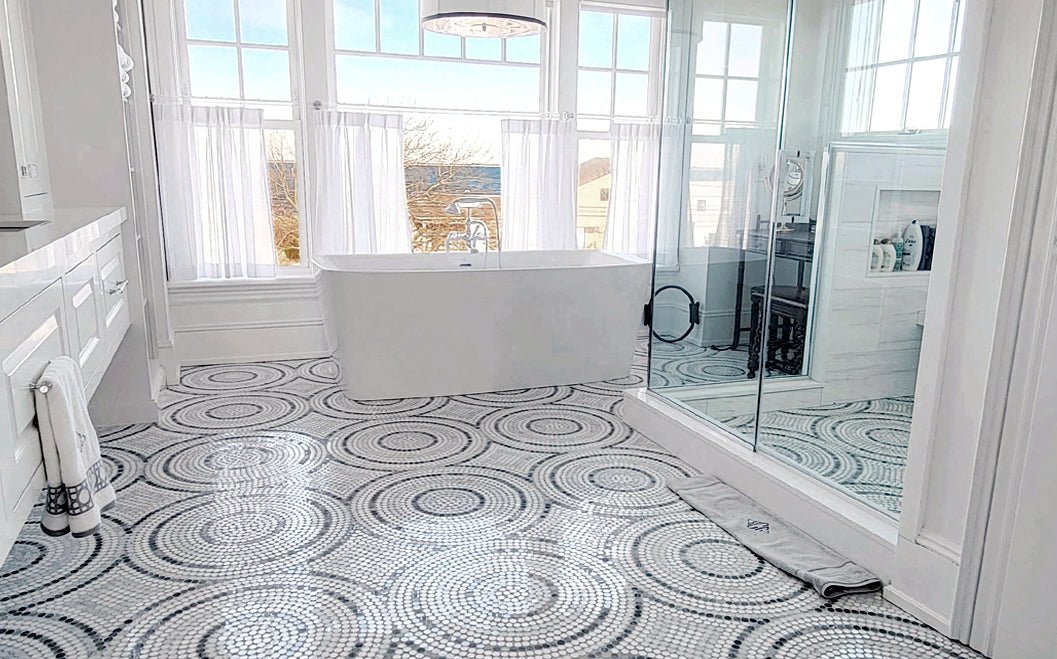You may have spent a lot of time musing over tile choices when starting a design project, but you should give equal importance on how to choose grout color for tile projects, too. Different grout colors for tile can produce startling contrasts or smooth out and make a design more cohesive, depending on your tile and grout choices, so do your research thoroughly. You aren't just stuck with gray or white grout anymore. You can even have white subway tiles with aquamarine blue grout, if you desire. There are endless color choices to make with grout, but they are most easily classified into three categories: dark, light, and neutral shades. Take a look at this guide to different grout colors to determine how you can best leverage this additional design element to the maximum.
#1 Dark Grout Color Choices
Black is obviously the darkest grout color available, but every color has a spectrum of color from lighter to darker. Blue grout can come in strong, dark, ultramarine shades, or light pastel blues. The more intense a color, the more it is likely to fall within the "dark" grout color choices. People tend to pick dark grout colors when they want to hide dirt or reduce the grout maintenance. However, dark grout does discolor over time, if using cleansers that fade it. Here is a brown grout color used to nicely contrast with the lighter tan tiles.

#2 Light Grout Color Choices
Light color choices are obviously near the whiter end of the spectrum. Light grout colors don't fade over time because they are already light. However, they don't hide dirt as easily as darker colors. The use of white with white or neutral colored subway tiles is a classic choice that is timeless and elegant. This example shows maroon subway tiles above the sink with white grout, which gives the kitchen a seamless and uniform appearance.

Waterjet Tile - View Details>>
#3 Neutral Grout Color Choices
White is considered a neutral as well as a light color, but so are lighter shades of gray and tan. A neutral color doesn't make a statement on its own and tends to recede into the background. Neutral colors don't include anything that provoke an emotional reaction from the viewer, like light shades of yellow, pinks, blues, or oranges might do. Gray is the trendiest grout color for design and has multiple applications, from contrasting to unifying a design, depending on what tile is chosen with it. Neutral grouts offer a subtle effect, as you can notice in this limestone floor where the gray color contrasts slightly with the lighter stone and matches the gray tiles. Neutrals have a soothing effect on the senses, regardless of whether they contrast or match the tile.

Limestone Tile - View Details>>
#4 Combining Grout Colors That Contrast with Your Chosen Tile
Understanding your three basic color choices in grout, you can start to figure out how to choose grout color for tile projects. If your tile color is light and you choose a dark color of grout, you are opting for a contrasting color design. The same is true if your tile color is dark and you choose a light colored grout. To get an idea how this affects your tile, let's take a look at the basketweave design done in contrasting, similar, and neutral colored grouts. These luxury homeowners chose a basketweave tile pattern with green grout, to help unify the design with their use of a green Soho strip border. However, if you look closely at the basketweave tile floor, your eye is instantly drawn to the "reeds" of the basket, which become quite prominent because of contrasting white and dark green colors.

#5 Combining Grout Colors Similar to Your Chosen Tile
Combining similar colors to the "reeds" in your chosen basketweave tile, whether dark or light choices, accentuates the contrasting "holes" in the basket design, and the "reeds" are less defined. It still looks like a basketweave, however. See how they used a dark brown grout with dark brown tile here to make the basket holes pop in comparison.

Basketweave Mosaic - View Details>>
#6 Using Grout Colors That Are Neutral in Tone
Finally, we are still viewing a basketweave design, but this time the color of grout is a light tan neutral and sort of fades into the background. You can see how the holes again seem to be more defined in the basketweave (since they are a contrasting black), however, the design is soothing because of its uniformity and neutral tones, unlike the first example with the dark brown grout, which offers a striking impact on the senses.

Here is another design using a light gray grout with gray "holes" and the entire design seems to recede into the background.


